|
living:
feature
 The
survival of celebrity The
survival of celebrity
Jack Yan
looks at two recent sports-celebrity endorsements—Maria
Sharapova for Sony Ericsson and Zinédine Zidane for IWC Schaffhausen—and
wonders how some remain on a high while others lay low after very
public slips

Above: Maria Sharapova in London, prior to Wimbledon, endorsing
her line for Sony Ericsson.
CELEBRITY
ENDORSEMENTS are a double-edged sword, whether those celebrities
are athletes, singers or movie stars. Phil Knight, one of Nike’s
founders, once remarked that in his company’s early days, it
could not afford to be on the back of Sports Illustrated—but
it might be able to be on the front cover. Hence, John McEnroe and
others, brilliant as they were, gave the swoosh some high-profile
endorsements.
Lucire ran a
piece on Anna Kournikova over six years ago, and was largely
positive about the effects of her celebrity, despite her less-than-stellar
performance in tennis. There were the negative effects, such as
the fact that companies were rewarding Kournikova’s looks rather
than her sporting ability, consequently sending a less-than-appropriate
message to the public: that we are a surface society, interested
in the image and not the substance.
At least when Sony Ericsson chose tennis star
Maria Sharapova to be its first global ambassador, it found someone
attractive to the eye and skilled in tennis, being a former
Wimbledon champion.
The Maria Sharapova Design Collection, unveiled
in London on June 20 on the eve of Wimbledon, consists of various
cases and travel wallets for cellphones, marketed as fashion items
with a catwalk show ‘by some of London’s up-and-coming faces,’
said the company.
CONTINUED BELOW 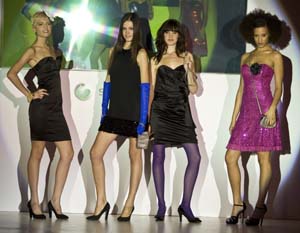
 
Above: Models showcase Sony Ericsson’s Maria Sharapova
Design Collection, available from the third quarter of 2008.
This seems a good endorsement: Sharapova is being
rewarded for her victories as well as her looks, and her achievements
make for a good role model.
In recent years there have been predictions such
as the death of reality TV, something
that still has not been realized—we must have heard that one
around 2000. In 2005, one photo agency was adamant in telling this
magazine that the celebrity cover was dead because of the overexposure
of Paris Hilton et al—only we noted that InStyle
had yet another increase in newsstand circulation. The interest
in celebrities, three years after the prediction, has not abated.
But what if the celebrity gets a wire or two
crossed? Britney Spears is most infamous—beyond the knickerless
partying incidents, her head-shaving showed the singer at an emotional
low, yet a few companies, including
Elizabeth Arden with numerous fragrances, have contracts where
they are compelled by law to keep promoting her.
There are ways out, of course. We
suggested that Spears could rescue her image ‘through authenticity.
Rather than say that a certain product has been inspired by Britney,
go inside her home and show that she is actively working on it during
her recuperation.
‘“Britney gets her act together,” the
headlines might read—and she can slowly begin showing that she is
not a victimized pop star but someone prepared to take charge and
deal with her problems.’ In effect, use the paparazzi and the
media’s fascination—not to mention the
institutionalized Britney economy as highlighted in Condé
Nast Portfolio that has to be fed—to get back on top.
‘[I]f there’s one thing the public loves more than a feel-bad
story, it’s the turn-your-life-around story,’ we wrote.
The other strategy is to wait it out. Marc Ellis
in New Zealand may have got busted on drugs but seems to have found
his way back to a prime-time TV show.
Cynics might point to the reverence New Zealanders hold for sporting
heroes who have represented the country. And the Zinedine Zidane
head-butting incident in the World Cup of 2006, which some said
marked his end, seems to have done him no harm as he endorsed a
new line of watches for IWC Schaffhausen
of Switzerland.
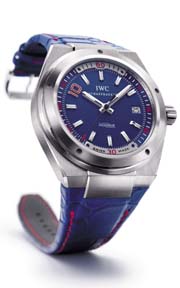 In
fact, football fans aside, Zidane’s positive image has persisted
more strongly, and IWC hasn’t
misjudged its timing with its new watch, the Ingenieur Automatic
Édition Zinédine Zidane. At the launch were numerous
celebrities from sports and film—Eva Longoria being the most
recognizable, international face, alongside her husband Tony Parker;
Jo Wilfried Tsonga, David Douillet, Christophe Lambert and Inès
Sastre were present. In
fact, football fans aside, Zidane’s positive image has persisted
more strongly, and IWC hasn’t
misjudged its timing with its new watch, the Ingenieur Automatic
Édition Zinédine Zidane. At the launch were numerous
celebrities from sports and film—Eva Longoria being the most
recognizable, international face, alongside her husband Tony Parker;
Jo Wilfried Tsonga, David Douillet, Christophe Lambert and Inès
Sastre were present.
The limited-edition 1,000-unit watch was launched
at a high-profile event at the Palais de Chaillot in Paris.
But ask academics and the answer would suggest
that Zidane wasn’t big enough to overcome the World Cup incident.
‘In today’s economy, athletes and celebrities push all
manner of products and services, and their travails can tarnish,
by association, the brands and companies that they endorse,’
said the
Wharton School of the University of Pennsylvania’s Knowledge@Wharton
magazine.
There, the wisdom is that ‘uber-endorsers’,
‘people who, out of a mix of achievement, personality and personal
history, manage to transcend their sport or field’ are able
to survive the bad. Lance Armstrong, Michael Jordan and Tiger Woods
are given as examples.
Martha Stewart and Paris Hilton managed to see
their profiles increase despite jail and a sex video respectively,
through careful management of their personal brands, the university
believes. We add Kate Moss, whose checking in to rehab after being
exposed for using cocaine has led to her bouncing
back into supermodelling.
While personal brand management is very important,
one has to wonder how active Zidane was—surely in the international
media, he has hardly been visible since his retirement from professional
football.
In an ideal world, we would like to believe that
the bad will tarnish a celebrity—Mel Gibson is laying low after
his drunken, anti-Semitic remarks, surfacing only to announce that
the Gibsons and Spearses would holiday together; and Michael Richards
has hardly been seen since publicly shouting the n word repeatedly.
In Zidane’s case, there was no racism, no
jail time, no controversial sex tape—but a spur-of-the-moment
reaction that has allowed him to resurface strongly. Few, we believe,
would even remember whom Zidane head-butted two years ago.
Perhaps it is our need to believe in some idols,
particularly in secular societies, wishing them to be visible because
we can all understand their inability to hold back. McEnroe remained
a strong endorser for a good part of his career, despite traditionalists
being appalled by his behaviour—even he believes his outbursts
made tennis more human. We wish we could have our outbursts and
how civility prevents them—beyond sports, even in fiction we
admire the political incorrectness of characters such as DCI
Gene Hunt in Ashes to Ashes.
What we might need to realize, since it is unlikely
we would stop championing the bad boys and girls of celebrity, is
that we are not rewarding these behaviours. We are staring at a
television or computer screen and we treat them as entertainment
or escapism, knowing full well they are poor examples of how we
might live our lives. We shouldn’t be fascinated by
this world, but all those people who swore they would not buy a
tabloid again, after the death of Diana, Princess of Wales 11 years
ago, don’t seem to have affected the sale of tabloid publications
one bit.
The danger comes in a society that believes that
these examples are normal: certainly that is where the criticism
of reality television stems from. If we are to guard against anything,
it is against becoming a surface society, not caring about the substance.
The right buzzwords and soundbites should not be a substitute for
character and hard work. And that puts that duty firmly back on
us, the media, for providing that context. •
Jack Yan is founding publisher of Lucire.
Add
to Del.icio.us | Digg
it | Add
to Facebook
|
In 2005, one photo agency was adamant in telling
this magazine that the celebrity cover was dead because of the overexposure
of Paris Hilton et al—only we noted that InStyle
had yet another increase in newsstand circulation. The interest
in celebrities, three years after the prediction, has not abated
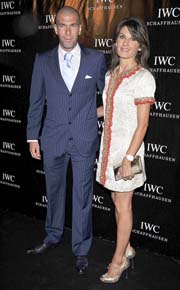
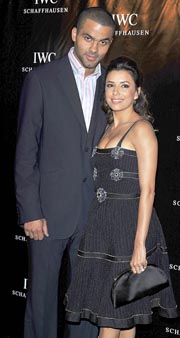
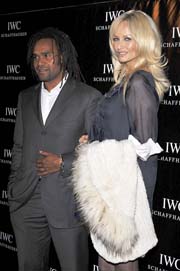
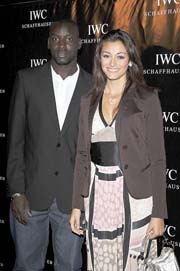
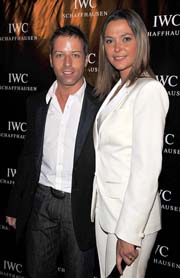

Above: Celebrities in Paris, celebrating the new IWC Schaffhausen
Automatic Édition Zinédine Zidane watch. Left:
IWC Schaffhausen’s new limited-edition watch, named for
French footballer Zinédine Zidane.
|

